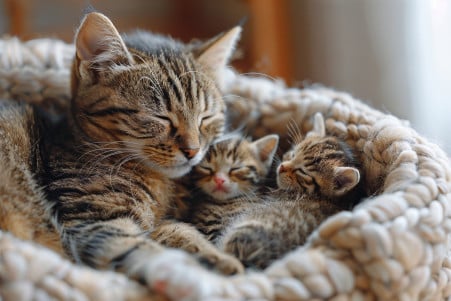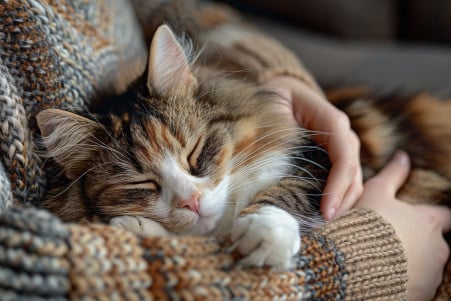How to Know If Your Cat Still Has Kittens Inside After Birth: Key Signs and Tips
3 June 2024 • Updated 3 June 2024

If you're noticing that your cat is acting strangely after giving birth, it's important to know whether or not she still has kittens inside. This can help you determine if you're dealing with a false alarm or a more serious issue. Signs that your cat may still have kittens inside include continued pregnancy behaviors, unproductive straining, swollen mammary glands, loss of appetite, and abdominal pain - if these symptoms continue, it's important to get her to the vet right away.
When it comes to birth complications and making sure that cat mothers are healthy, we'll explore the advice of veterinary professionals to help you understand how to assess and respond to signs that there may still be kittens inside. By looking at clinical studies on feline reproduction and referencing experienced cat breeders, you'll get a well-rounded view of how to tell if your cat has fully given birth. This information could be helpful for any concerned pet owner who wants to make sure that their cat and her kittens have the best chance at a healthy outcome.
How do you know if your cat still has kittens inside after birth?
Knowing When to Expect the Kittens
Cat pregnancies typically last between 63 to 65 days, or about nine weeks, although some litters may be born a day or two earlier or later. Labor is divided into three stages:
- The uterus muscles contract and tighten.
- The active stage of labor, when the kittens are born. The first kitten should be born within 1-2 hours of the start of contractions.
- The placenta is expelled, usually 5-15 minutes after the kitten is born.
Between kittens, there is often a break of 10-60 minutes, according to the PDSA. That said, it's common for cats to have "interrupted labor" where they may stop and rest for up to 36 hours before contractions resume and the remaining kittens are born.
If the cat has strong contractions for more than 2 hours without a kitten being born, or if more than 3 hours pass between kittens when you know there are more to be born, this could be a sign of a problem that requires veterinary attention. Prolonged labor can lead to complications for both the mother and the unborn kittens, so it's important to keep a close eye on the time between kitten births.
When to Get Veterinary Help for Cat Labor
If your cat is having strong contractions for more than 30 minutes without producing a kitten, or if you can see a kitten stuck in the birth canal, you should call your vet immediately. Vets Now also says, other signs that your cat needs to be seen by a vet right away include heavy bleeding, a retained placenta, or if the cat is depressed, lethargic or has a fever.
These issues can be caused by mechanical blockages, like a kitten that's too big or in the wrong position in the birth canal, or uterine inertia, which is when the uterine muscles are too weak to push the kittens out. WagWalking explains that your vet will probably do a physical exam and take a medical history to determine the cause.
Treatments may include drugs to induce labor, or in more serious cases, a C-section. HowStuffWorks explains that cats tend to recover from C-sections quickly, with most cats being alert, stable and able to nurse their kittens within a few hours.
Secure Home Care for a Pregnant Cat
It's important to make sure your cat is comfortable and safe in her home environment when she goes into labor. Per Cats Protection, you can do this by creating a nesting area in a warm, quiet, draft-free location like a cardboard box or cat carrier that's lined with soft towels or blankets. Make sure the location is easy for your cat to get to, but away from any potential disruptions from kids or other pets.
Once your cat goes into labor, it's best to watch from afar and avoid intervening unless absolutely necessary. Per wikiHow, you may need to help if a kitten gets stuck during the birthing process or if the mother cat doesn't break the amniotic sac or chew through the umbilical cord. If you need to help, make sure you have clean hands and supplies, and be very careful to avoid hurting the kitten.
According to Purina, it's also important to keep a close eye on the mother and kittens after the birth to make sure they're nursing and doing well. You should also make sure the mother has easy access to food and water near her nesting area so she can stay strong and keep her milk supply up during this time.
Preventing Future Complications: Spaying and Responsible Breeding
Preventing future complications from cat pregnancy is important, and it all begins with spaying female cats. Per the Feline Veterinary Emergency and Specialty Center, spaying helps prevent unplanned pregnancies and the potential for complications during birth. The best time to spay a cat is after they have weaned their kittens, which is usually 4-6 weeks after giving birth.
Breeding cats can also lead to a number of complications, including genetic problems and infectious diseases that can affect both the mother and the kittens. As explained by wikiHow, responsible breeding is important, and that includes making sure the cat is up to date on vaccinations and has been dewormed, and that they receive regular, comprehensive veterinary care throughout their pregnancy and while they are nursing their kittens.
It's also important to make sure that pregnant and nursing cats are in a healthy, low-stress environment. Purina recommends providing a quiet, comfortable nesting area, easy access to food and water, and keeping a close eye on the mother and kittens after the birth. By focusing on prevention, cat owners can help make sure that both the mother and her kittens are healthy.
Conclusion: How to Make Sure Your Cat and Her Kittens Stay Healthy During Delivery
If you see any of the warning signs after your cat has given birth, including vaginal discharge, a prolapsed uterus, mastitis, a lack of appetite, or strange behavior, it's important to call your vet right away. According to Cats Protection, these symptoms could indicate a medical emergency that could put the mother and her kittens at risk.
In some cases, a mother cat may not be able to care for her kittens. The Spruce Pets notes that if the kittens aren't nursing, you may need to ask your vet about the possibility of hand-rearing them. However, it's important to make sure that you're watching the mother and her kittens closely for any issues that may arise.
Responsible breeding and preventative measures like spaying can help reduce the risk of future complications. By providing good care and monitoring the birthing process, cat owners can help catch potential problems early and get the help they need. While welcoming new kittens into the world can be an exciting experience, the health of the mother cat should always be the top priority.


